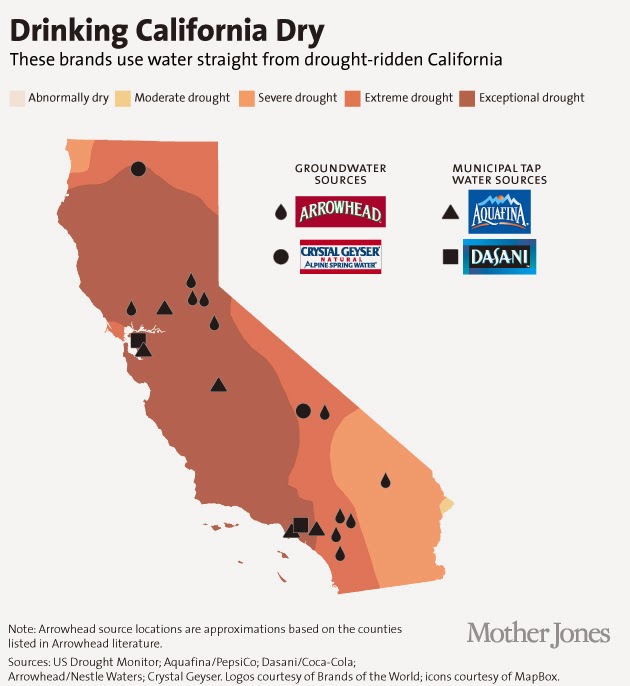We're all familiar with our bottled water. Many of use it every day, but it doesn't mean it's healthy for us nor is it for the environment. According to EPA (below article), the bottled water we're drinking likely comes from the drought stricken California.
It doesn't make sense that we take water from a drought area, so why California? Two main reasons: 1.) Large companies like Arrowhead, Dasani, Crystal Geyser and Aquafina have shops situated in California.
2.) There is no strict groundwater regulations in California. Basically, you can dig up your own water and call it your own.
Our bottled water either comes from natural springs or groundwater. They're still basically tap water that goes under treatment. But if there's poor regulation and water companies are not required to publicly disclose where their water resource come from, shouldn't it be a health concern for us bottled water drinkers? Especially when majority of them comes from a state where water availability is rough..? And of course, this is not to mention the detrimental effects it has on the environment through depletion of water resources and bottled water wastes that pollute lands and the ocean.
Bottled-water drinkers, we have a problem: There's a good chance that your water comes from California, a state experiencing the third-driest year on record.
The details of where and how bottling companies get their water are often quite murky, but generally speaking, bottled water falls into two categories. The first is "spring water," or groundwater that's collected, according to the EPA, "at the point where water flows naturally to the earth's surface or from a borehole that taps into the underground source." About 55 percent of bottled water in the United States is spring water, including Crystal Geyser and Arrowhead.
The other 45 percent comes from the municipal water supply, meaning that companies, including Aquafina and Dasani, simply treat tap water—the same stuff that comes out of your faucet at home—and bottle it up. (Weird, right?)
But regardless of whether companies bottle from springs or the tap, lots of them are using water in exactly the areas that need it most right now.
One reason is simply that California happens to be where some bottled water brands have set up shop. "You have to remember this is a 120-year-old brand," said Jane Lazgin, a representative for Arrowhead. "Some of these sources have long, long been associated with the brand." Lazgin acknowledges that, from an environmental perspective, "tap water is always the winner," but says that the company tries to manage its springs sustainably. The water inside the bottle isn't the only water that bottling companies require: Coca-Cola bottling plants, which produce Dasani, use 1.63 liters of water for every liter of beverage produced in California, according to Coca-Cola representative Dora Wong. "Our California facilities continue to seek ways to reduce overall water use," she wrote in an email.
Another reason we're drinking California's water: California happens to be the only Western state without groundwater regulation or management of major groundwater use. In other words, if you're a water company and you drill down and find water in California, it's all yours.
Despite the fact that almost all US tap water is better regulated and monitored than bottled, and despite the hefty environmental footprint of the bottled water industry, perhaps the biggest reason that bottling companies are using water in drought zones is simply because we're still providing a demand for it: In 2012 in the United States alone, the industry produced about 10 billion gallons of bottled water, with sales revenues at $12 billion.
As Gleick wrote, "This industry has very successfully turned a public resource into a private commodity." And consumers—well, we're drinking it up.
Source
"A better attitude leads to better actions and a better world..."


No comments:
Post a Comment